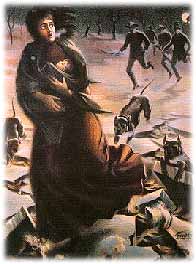At the beginning of the novel, Dick, posing in a gentleman’s clothes, has the following interchange with Frank Whitney:
"Who'd take Ragged Dick?"
"But you aint ragged now, Dick."
"No," said Dick; "I look a little better than I did in my Washington coat and Louis Napoleon pants. But if I got in a office, they wouldn't give me more'n three dollars a week, and I couldn't live 'spectable on that."
Despite his appearance as a gentleman, he still identifies himself as Ragged Dick in this passage, but at the end of the novel, while posing as Ragged Dick to retrieve his mail, he refuses to identify himself by that name:
"Are you Ragged Dick?"
"If you don't believe me, look at my clo'es," said Dick.
"That's pretty good proof, certainly," said the clerk, laughing. "If that isn't your name, it deserves to be."
"I believe in dressin' up to your name," said Dick.
This final line strikes the reader as ironic because Dick Hunter is posing as his old self, Ragged Dick. There is no question that Ragged Dick is completely transformed into a gentleman when he becomes Richard Hunter, Esq., but the question remains: How is he transformed? Is it through his honesty, generosity, and charming good looks that he makes a good name for himself? Or is it solely through trading favors for fine clothes that he raises himself from rags to riches, from a flawed boy to moral one? What is the cause of his turn of good fortune, his morality or the effects of his reward—the clothing?
Each time Dick does a good deed, he becomes better fitted to be a gentleman, whether in appearance or manner. When he offers to show Frank the town, he gets Frank’s suit and extra “gift[s] of a shirt, stockings, and an old pair of shoes” and discovers that he actually likes the “sensation of cleanliness.” The day after his receipt of Frank’s second-hand finery, Dick feels “ashamed” of his old attire. Only in his new clothes does he decide that he “must try to earn a little more.” From this point on his jokes about his tattered coat that was once George Washington’s vilify his old attire, his old self, contradicting his earlier assertion that the coat made him a “smart young feller.” When Dick gives Fosdick the majority of his savings to buy a suit to improve his appearance, Dick handles the money in “the off-hand manner” of a gentleman and is treated as such. When he saves Mr. Rockwell’s boy, he receives the “best suit he had ever worn.” He finally grew into the gentleman’s role because the gentleman’s clothes “fit . . . him as well as if it had been made expressly for him.” Having metamorphosed into a gentleman with a job and wardrobe, he finds his Washington coat and Napoleon pants have been stolen. Essentially, all parties assume that increasingly wealthy clothing means a new station in life as a gentleman, as Richard Hunter, Esq.
At the very beginning, when Dick asserts that nothing, particularly his ability to live a “‘spectable” lifestyle, has changed because of his clothes, Frank follows with these lines, which are very telling if compared to Dick’s suits of clothing:
“That reminds me," [Frank] said, "of the story of an Irishman, who, out of economy, thought he would teach his horse to feed on shavings. So he provided the horse with a pair of green spectacles, which made the shavings look eatable. But unfortunately, just as the horse got learned, he up and died."
"The hoss must have been a fine specimen of architectur' by the time he got through," remarked Dick.”
Dick’s suits function as the green spectacles, making frugality and self-control “look eatable,” while all the while he, like the little boy who read Alger’s tales of rags-to-riches, is being sculpted into a gentleman, until he essentially loses his old self.

Word Count: 685







